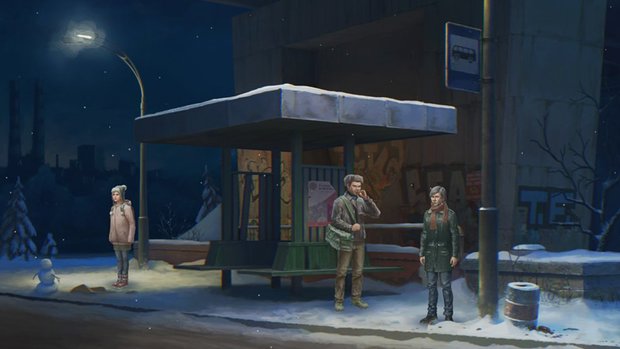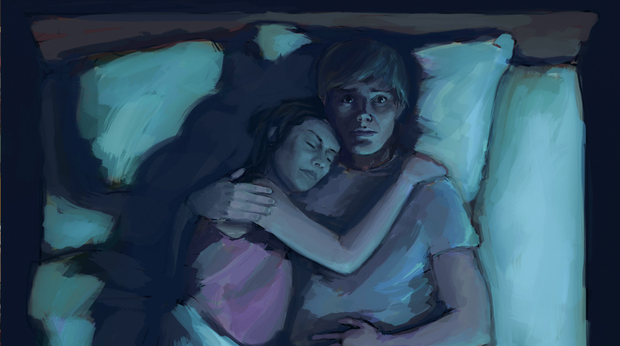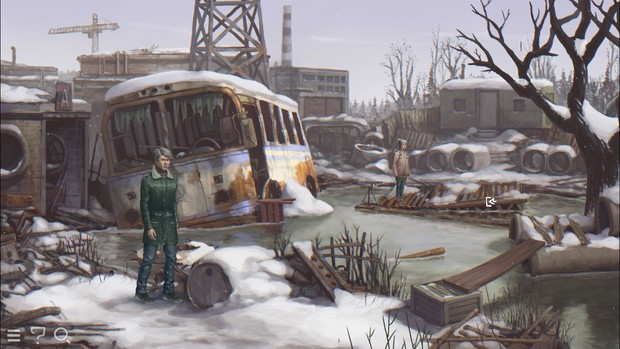The Safe Place review – No escaping the unapologetically bleak atmosphere of this gritty urban adventure

- 1 Comment
On paper The Safe Place has everything I personally love best in adventure games: a story set in the “real” world, loads of inventory puzzles instead of code-breaking or mind-numbing brainteasers, and a dramatic story in true thriller fashion that should create an emotional attachment with the main character. It’s a shame, then, that something about it doesn’t sit well with me, preventing me from enjoying it more. Many of those inventory puzzles are tricky, making it tempting to use the hotspot locator and in-game hint system, even though I hate doing that because it always feels like cheating to me. Perhaps if the main character was more likable, I might have tried harder to figure things out on my own. But it’s difficult pretending to be such an impulsive character not always taking the best course of action, over whom you have no control at precisely the times it matters most.
You play as Alexander, who works as an engineer in a post-Soviet city factory. Times are rough, and the company hasn’t paid his salary for the last three months. With a wife at home taking care of their young daughter, Alex looks into other means of providing for them: stealing the factory’s iron supply to sell on the black market. On the night of the heist, however, everything goes wrong. The stolen goods are in turn stolen from Alex, but he tracks it down to a stranger standing at a nearby bus stop, and here is where you take control of the situation. At least, up until the next big cutscene in beautifully illustrated graphic novel style, in which Alex manages to make things even worse and turn the situation completely FUBAR. There’s blood on his hands now, and complicating matters, there’s a witness. And 12-year-old Christina, with troubles of her own, could really use some help from a responsible (ahem) adult, with bullies torturing her and a jailbird father threatening the lives of her and her mother.
The game’s developer is Ukraine-based Anate Studio, who previously released Little Kite (2017) and Repentant (2018), which are identical to The Safe Place in graphic style, gameplay and setting. While not necessary to play them all, the plots of these games share the same universe and have one or more common characters (in this case, young Christina made her first appearance in Repentant). All three games feature dramatic and deep social plots, showing the darkest side of society and human nature. There’s no sugarcoating here: all the blood and abuse is thrown right in your face. These games present reality as brutal as it can be, complete with every vice imaginable. They’re a sobering reflection on what it means to be poor or how necessity can turn humans into monsters.

Despite the heavy premise, the point-and-click gameplay is pretty standard: search the scenes for items, then use them on the right hotspots. Or combine inventory to make new equipment first. Chapter one starts with a single scene, while later chapters add extra rooms, up to a total of five to explore at any one time. You examine things with either mouse button, and if an object can be picked up, Alex will do so, though he won’t always give a description. Hotspots don’t have any labels when hovering over them either; the cursor simply changes to indicate an interaction is possible. Combined with the fact that you can’t even examine an item once it’s in your inventory, you often can’t be sure what it is you’re carrying around, which makes it hard to imagine where and how to use it.
That’s if you can find them in the first place, because hotspots don’t always stand out enough in the realistic hand-drawn settings. Thankfully there’s a hotspot locator in case you want to check whether you’ve missed anything. And trust me, you’ll probably have to, because sometimes there are different parts to the same object, each with its own hotspot, some of which can be very small. Due to the lack of labels you could easily overlook one of them until you hit that little magnifying glass in the bottom left corner of the screen to highlight everything.
While playing, it’s easy to imagine the flow chart the developer had in mind; there’s real structure between the puzzles and the story. But the difficulty level of the solutions is all over the place. For instance, at one point, you need to light a certain object on fire. You already have something that burns, but apparently it’s not enough to do the job. Instead there’s another whole step involved for no reason besides making the puzzle harder. There’s only ever one way to solve a puzzle, and often I found myself not thinking about it as the game’s player or even as the main character, but actually wondering in my head, “What would the developer of this game want me to do at this point?” Which sadly breaks the illusion.

In a few instances you have to solve a more mechanical kind of puzzle, but these are limited to things like fixing a washing machine, connecting the right cables in a fuse box, freeing a chain from a post, putting gears on the right axle, or finding different-shaped wooden puzzle pieces to put in their right place in a box. Another box has various colored buttons on top, and you have to press them in the right sequence to open it. I got that on my second try, but it was a lucky shot since I still have no idea where the actual solution comes from. These puzzles are never that hard, and come as something of a relief after spending so much time trying to figure out what to do with your inventory.
The goals in this game are always clear. There are several additional characters involved, like Alex’s co-workers and a neighbor, to guide you along – or in some cases to provide obstacles. Dialogues are fully voiced, and though the actors do a splendid job, sometimes the script is so over the top and things become so melodramatic, it almost turns unintentionally funny and you just want to tell the characters to chill. Which is unfortunate, because there’s absolutely nothing to laugh about in this storyline.
During conversation, the dialogue text appears next to a character portrait in typewriter style, the lines appearing letter by letter, word by word, although you can left-click to make the text immediately appear in its entirety, which I preferred. But text speed isn’t adjustable and isn’t perfectly aligned with the spoken words. The voice actor is always behind, which has an irritating effect. Then, once the actor has performed their lines, the text stays on-screen for quite a long time. It will move on automatically eventually, but here too you’ll almost certainly choose to left-click to move on to the next paragraph.

If you really find yourself in a bind, with no idea how to proceed, there’s help available this time. The developer seems to have learned from feedback to the previous games and has added a hint system here. In each scene you can find little statuettes. By clicking the on-screen hint icon you open up a list of all puzzles, ready to show which items you must combine or use on each other to solve them. But the hints remain hidden until you pay to reveal them by exchanging a found statuette. A very simple yet ingenious way to turn asking for a hint into somewhat of a puzzle itself – or at least a pixel hunt, because these statuettes don’t show up with the hotspot locator. Be careful when using one, though, because ALL the puzzles in the current section of the game are listed, and you might inadvertently spoil other solutions while you’re at it.
The Safe Place is divided into distinct sections that usually involve traveling to the next location, or group of locations, as the story progresses. You start at a bus stop, then return to Alex’s house where you’ll need to get rid of some evidence. Later on you’ll find yourself at his workplace to trick some co-workers and make off with another stolen batch of material, followed by visiting a complex of garage boxes to protect Christina from her bullies, and eventually you’ll have to puzzle your way through an apartment building and prepare yourself for a final showdown. Sometimes you’ll revisit previous locations with changed circumstances.
Each time you begin a new section, your inventory is completely reset. Most of the time this means your acquired items are discarded, but for some sections Alex will automatically bring along some new items he picked up on the way. Starting a new section is also the only time the game saves. It does create a new save file each time, making it easy to go back to an earlier section if you want. But you can’t save manually, annoyingly enough, so make sure you have plenty of time left before beginning a new section. Otherwise, you’ll find yourself redoing a huge part of the game when you return. Depending on how good you are at the puzzles, a chapter could take you from twenty minutes to a full hour.
As good as the game looks and sounds – the dark and eerie music perfectly accompanies the great graphics and grim atmosphere – what I found lacking while playing The Safe Place was any sense of fun. I didn’t feel anything besides pity for the secondary characters during the five hours it took me to finish the game, and I disliked Alex as a human being. Perhaps it’s an accurate portrayal of a desperate man’s actions under awful circumstances; you never know how you’re going to react in a crisis. It could very well be that I would do exactly the same if I were in Alex’s shoes. But I’d like to see myself as a better person who wouldn’t make the decisions he does, and felt frustrated by my inability to impact his choices as the player. As it is, he’s very much an antihero that I couldn’t root for like I do with adventure game heroes.
Between my antipathy for the protagonist and some of the needlessly artificial gameplay difficulty, I found myself simply going through the motions, solving the necessary puzzles, to work my way towards the end of the game, trying very hard not to get too depressed by the events as they unfolded. It’s a difficult balance for the developer, because when it comes to content, there’s a valid critique of society here, and it handles heavy themes many games avoid. As a storytelling device, it’s brilliant for drawing you in. But as a game to be enjoyed, this is definitely not for players just looking for a good time. However, those who are very much concerned about current affairs and the many dangers lurking in the dark corners of the world will at least appreciate this raw depiction of a poor Eastern European family man trying to do what’s best for his loved ones.
Final Verdict
True life isn’t all fun and games, which is clearly reflected in The Safe Place. It’s a story of poverty, domestic abuse and crime; of struggling to overcome being a victim of others or simply of circumstance. It’s an unapologetically dark story set in a realistic world and filled with misery. Some of the pain is inflicted by inventory puzzles that even experienced adventure gamers will find needlessly tricky, although at least there’s a hint feature this time around. The main character makes loads of bad decisions along the way, over which you as the player have disappointingly little control, making him very unsympathetic and draining away any feeling of satisfaction from what might otherwise be an emotionally gut-wrenching story. There is much to appreciate here, but it can feel more like work to get to the good parts sometimes. I’d probably appreciate it more as a novel or movie, but as a game it falls a bit short in granting a memorable gaming experience.
Hot take
The gritty, realistic urban setting is stunning, but the story of The Safe Place is so drearily centered on poverty, crime and abuse that succeeding in cracking the more difficult inventory puzzles becomes more of a struggle than a pleasure just to progress and see more misery unfold.
Pros
- Gorgeous, realistically rendered hand-drawn environments
- Challenging inventory obstacles sprinkled with a few standalone puzzles
- Powerful reflection on the effects of real-world poverty and abuse
- Hint system offers cleverly limited use
Cons
- Unsympathetic main character
- No hotspot labels or descriptions of inventory items
- No manual save system
- Story is too relentlessly depressing
Johnny played his own copy of The Safe Place on PC.

- Advertisement
- Help support AGH by advertising with us











1 Comment
Want to join the discussion? Leave a comment as guest, sign in or register.
x Story is too relentlessly depressing This was definitely a pro for me. I'm so tired of all the PnC games with cartoony graphics, animal characters or childish presentation. It's refreshing to have a PnC game with more realism and mature themes.
Reply
Leave a comment